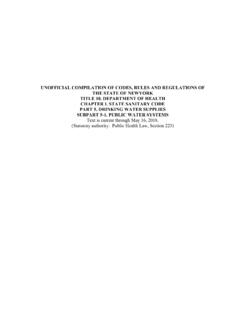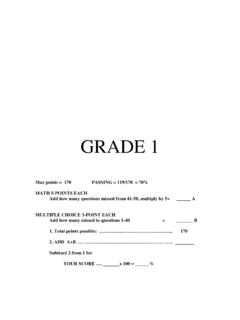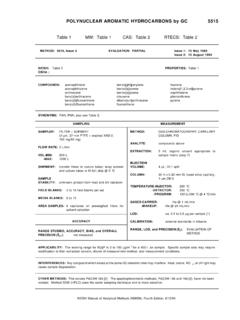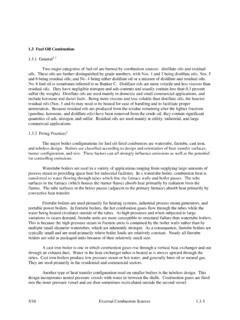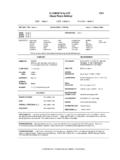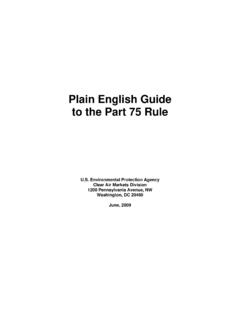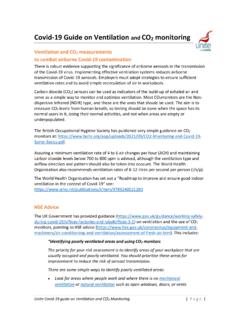Transcription of Hydrogen Fuel Quality Specifications for Polymer ...
1 Hydrogen Fuel Quality Specifications for Polymer Electrolyte Fuel Cells in Road VehiclesReport to the Safety, Codes and Standards ProgramFuel Cell Technologies Office Department of EnergyPublished November 2, 2016 (This page intentionally left blank)(This page intentionally left blank) iHYDROGEN FUEL Quality Specifications FOR Polymer ELECTROLYTE FUEL CELLS IN ROAD VEHICLESA uthorsLead Authors: James M. Ohi, Nicholas Vanderborgh, Gerald Voecks Consultants Contributing Authors: Shabbir Ahmed, Romesh Kumar, Dennis Papadius Argonne National Laboratory, Tommy Rockward, Los Alamos National LaboratoryAcknowledgementThe authors would like to acknowledge Antonio Ruiz, technology manager of the Safety, Codes and Standards program (SCS) in the Department of Energy s Fuel Cell Technologies Office (FCTO), whose guidance and support were critical to the team s success.
2 Preceding SCS managers Pat Davis, Dr. Sig Gronich, and Neil Rossmeissl and current SCS manager Will James also provided critical guidance and support. We also thank Nancy Garland and Fred Joseck of the FCTO, who encouraged and enabled collaboration among researchers affiliated with different FCTO programs. The authors also acknowledge the leadership of the convener of International Organization for Standardization (ISO) Technical Committee (TC) 197 Working Group 12 (WG12), Professor Yasuo Takagi of Tokyo City University, and the secretary of WG12, Dr. Hidenori Tomioka of the Japan Automobile Research work described in this report could not have been accomplished without the invaluable contributions of the team of experts who conducted the testing, modeling, and analysis to help develop the ISO and SAE International (SAE) standards. Many thanks to the team members listed below, including their affiliations during the height of team activity between 2006 and 2008.
3 This report was originally submitted to FCTO on November 30, 2012 as a supplement to the development of the fuel Quality Liquide Robert Benesch, Martin Carre Air ProductsDave Guro, Tom JosephArgonne National LaboratoryRajesh Ahluwalia, Shabbir Ahmed, Romesh Kumar Ballard Power Systems (Canada)Silvia WesselBPJim SimnickCalifornia Fuel Cell Partnership Jackie BirdsallCEA (France)Laurent Antoni, Olivier Lemaire ChevronBhaskar Balasubramanian, John Lemen Daimler-ChryslerGeorge Mitchell , Jesse SchneiderGeneral Motors Mike Steele, Fred WagnerJapan Automobile Research Institute Motoaki Akai Linde (BOC Group)Bob BoydLos Alamos National LaboratoryTommy Rockward, Ken Stroh, Francisco UribeNational Hydrogen Association (NHA)Karen HallHYDROGEN FUEL Quality Specifications FOR Polymer ELECTROLYTE FUEL CELLS IN ROAD VEHICLESii (This page intentionally left blank)
4 IiiHYDROGEN FUEL Quality Specifications FOR Polymer ELECTROLYTE FUEL CELLS IN ROAD VEHICLEST able of ContentsAcknowledgement iTable of Contents iii1 Introduction vii1 1 Background vii1 2 Preparation of ISO FDIS 14687-2 and SAE J2719 viii1 3 Hydrogen Fuel Quality and PEM Fuel Cell Degradation 21 4 Fuel Cell System and Vehicle Considerations 32 Approach 42 1 Rationale 42 2 Limitations and Caveats 83
5 Single-Cell Testing 93 1 Test Plan 93 2 Data Reporting Format 103 3 Single-Cell Round Robin Tests 123 4 Single-Cell Tests with Common Membrane Electrode Assemblies 133 5 Single-Cell Test Results 143 5 1 Carbon Monoxide (CO) 143 5 2 Total Sulfur Compounds 193 5 3 Ammonia (NH3)
6 233 5 4 Hydrocarbons and Halogenated Compounds 253 5 5 Inert Compounds, Oxygen, and Water 263 5 6 Binary and Multiple Contaminant Mixtures 273 5 7 Particulate matter 29 Hydrogen FUEL Quality Specifications FOR Polymer ELECTROLYTE FUEL CELLS IN ROAD VEHICLESiv 4 Single-Cell Test Results and Real-World Polymer Electrolyte Membrane Fuel Cell Vehicle Operating Conditions 314 1 Acceptable Performance and Durability Losses Due to Fuel Contaminants 314 2 Effects of Operating Conditions
7 324 2 1 Fuel Cell Tech Team Performance and Durability Test Protocols 324 2 2 Temperature, Pressure, Relative Humidity, Stoichiometry 324 2 3 Cell Potential and Duty Cycle 334 2 4 Shutdown Startup 334 2 5 Fuel Cell Battery Hybridization 335 Modeling 345 1 Contamination Models
8 345 2 Stack Modeling 356 Field Data 396 1 Controlled Hydrogen Fleet and Infrastructure Demonstration and Validation Project (United States) 396 2 Japan Hydrogen and Fuel Cell Demonstration Project 406 3 Other Demonstration Projects 417 Analysis 427 1 Cost Benefit Analysis and Trade-offs Fuel Quality versus Fuel Cost 427 1 1 Production Purification System 427 1 2 Analysis Assumptions 437
9 2 Steam Methane Reforming Pressure Swing Adsorption Modeling Results 447 2 1 Base Case 447 2 2 Limiting (Canary) Species 457 2 3 Process Optimization Effect of S/C and Pressure 46 vHYDROGEN FUEL Quality Specifications FOR Polymer ELECTROLYTE FUEL CELLS IN ROAD VEHICLES7 3 Cost Analysis 487 3 1 Cost of Hydrogen 487 3 2 Fuel Cell Performance versus Fuel Quality 507 3
10 3 Quality Assurance Requirements and Costs 507 4 Summary and Conclusions 518 Analytical Methods and Quality Control 528 1 Perspectives of Fuel Providers 528 2 ASTM Standardized Analytical Methods 538 3 Detection Limits 558 4 Quality Assurance 578 4 1 Near-Term Quality Assurance Considerations 589 Summary and Conclusion 59 Appendix A Acronyms and Initialisms 61 Appendix B The Literature of Contaminant Effects on Fuel Cell Performance












